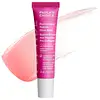What's inside
What's inside
 Key Ingredients
Key Ingredients

 Benefits
Benefits

 Concerns
Concerns

 Ingredients Side-by-side
Ingredients Side-by-side

Hydrogenated Polyisobutene
EmollientPolybutene
Diisostearyl Malate
EmollientBis-Diglyceryl Polyacyladipate-2
EmollientGlyceryl Behenate
EmollientSynthetic Beeswax
Emulsion StabilisingCaprylic/Capric Triglyceride
MaskingButyrospermum Parkii Butter
Skin ConditioningCetearyl Ethylhexanoate
EmollientEthylhexyl Palmitate
EmollientRicinus Communis Seed Oil
MaskingDimethyl Isosorbide
SolventPalmitoyl Tripeptide-1
Skin ConditioningPalmitoyl Tripeptide-38
Skin ConditioningTridecapeptide-1
Skin ConditioningSesamum Indicum Seed Extract
Skin ConditioningPortulaca Pilosa Extract
Skin ConditioningPentylene Glycol
Skin ConditioningPrunus Domestica Seed Oil
Skin ConditioningWater
Skin ConditioningSodium Hyaluronate
HumectantTribehenin
EmollientSorbitan Isostearate
EmulsifyingHydrogenated Castor Oil
EmollientLactic Acid
BufferingTocopherol
AntioxidantSucrose Cocoate
EmulsifyingVanillin
MaskingCI 15850
Cosmetic ColorantHydrogenated Polyisobutene, Polybutene, Diisostearyl Malate, Bis-Diglyceryl Polyacyladipate-2, Glyceryl Behenate, Synthetic Beeswax, Caprylic/Capric Triglyceride, Butyrospermum Parkii Butter, Cetearyl Ethylhexanoate, Ethylhexyl Palmitate, Ricinus Communis Seed Oil, Dimethyl Isosorbide, Palmitoyl Tripeptide-1, Palmitoyl Tripeptide-38, Tridecapeptide-1, Sesamum Indicum Seed Extract, Portulaca Pilosa Extract, Pentylene Glycol, Prunus Domestica Seed Oil, Water, Sodium Hyaluronate, Tribehenin, Sorbitan Isostearate, Hydrogenated Castor Oil, Lactic Acid, Tocopherol, Sucrose Cocoate, Vanillin, CI 15850
Ricinus Communis Seed Oil
MaskingPetrolatum
EmollientEuphorbia Cerifera Wax
Lanolin
EmollientC10-30 Cholesterol/Lanosterol Esters
EmulsifyingCera Alba
EmollientOzokerite
Emulsion StabilisingEthylhexyl Palmitate
EmollientCopernicia Cerifera Wax
Butyrospermum Parkii Butter
Skin ConditioningJojoba Esters
EmollientTriticum Vulgare Germ Oil
EmollientBisabolol
MaskingTetrahexyldecyl Ascorbate
AntioxidantTocopheryl Acetate
AntioxidantTrihydroxystearin
Skin ConditioningHydrogenated Polyisobutene
EmollientRicinus Communis Seed Oil, Petrolatum, Euphorbia Cerifera Wax, Lanolin, C10-30 Cholesterol/Lanosterol Esters, Cera Alba, Ozokerite, Ethylhexyl Palmitate, Copernicia Cerifera Wax, Butyrospermum Parkii Butter, Jojoba Esters, Triticum Vulgare Germ Oil, Bisabolol, Tetrahexyldecyl Ascorbate, Tocopheryl Acetate, Trihydroxystearin, Hydrogenated Polyisobutene
 Reviews
Reviews

Ingredients Explained
These ingredients are found in both products.
Ingredients higher up in an ingredient list are typically present in a larger amount.
This ingredient is also known as shea butter. It is an effective skin hydrator and emollient.
Emollients help soothe and soften your skin. It does this by creating a protective film on your skin. This barrier helps trap moisture and keeps your skin hydrated. Emollients may be effective at treating dry or itchy skin.
Shea butter is rich in antioxidants. Antioxidants help fight free-radicals, or molecules that may harm the body. It is also full of fatty acids including stearic acid and linoleic acid. These acids help replenish the skin and keep skin moisturized.
While Shea Butter has an SPF rating of about 3-4, it is not a sunscreen replacement.
Shea butter may not be fungal acne safe. We recommend speaking with a professional if you have any concerns.
Learn more about Butyrospermum Parkii ButterEthylhexyl Palmitate, also known as octyl palmitate, is created from 2-ethylhexyl alcohol and palmitic acid. It is a fatty acid ester.
The fatty acid content of Ethylhexyl Palmitate makes it an emollient. Emollients help soften and hydrate your skin by trapping moisture within.
Ethylhexyl Palmitate is also used to help improve the texture of cosmetics. It helps other ingredient dissolve in products and help disperse ingredients more evenly.
You'll likely find this ingredient in sunscreen, as it is often used to mix UV-blocking ingredients such as avobenzone and ethylhexyl triazone.
It can also help stabilize the fragrances in a product as a fragrance fixative.
Ethylhexyl Palmitate can be used to substitute mineral oil.
Due to its high fatty acid content, it may not be fungal-acne safe.
Learn more about Ethylhexyl PalmitateHydrogenated Polyisobutene is a synthetic polymer. Polymers are compounds with high molecular weight. Hydrogenated Polyisobutene is an emollient and texture enhancer.
In one study, Hydrogenated Polyisobutene showed better skin hydration levels than Caprylic/Capric Triglyceride. As an emollient, it helps keep your skin soft and hydrated by trapping moisture in.
Hydrogenated Polyisobutene is often used as a mineral oil replacement.
Learn more about Hydrogenated PolyisobuteneRicinus Communis Seed Oil is the INCI name for castor oil.
Castor Oil helps moisturize the skin. It is rich in a fatty acid called ricinoleic acid. This fatty acid helps prevent moisture loss on the skin. This helps keep your skin soft and hydrated. Ricinoleic acid also has anti-inflammatory and pain reducing properties.
Besides hydrating the skin, castor oil is also used to hydrate hair. By keeping the hair shaft moisturized, breakage is decreased. More studies are needed to show castor oil's effective on stimulating hair growth.
Castor oil is created by cold-pressing castor seeds and then purifying the oil with heat. It was used in Ancient Egypt as fuel in lamps and to help treat eye irritation.
The term 'fragrance' is not regulated in many countries. In many cases, it is up to the brand to define this term. For instance, many brands choose to label themselves as "fragrance-free" because they are not using synthetic fragrances. However, their products may still contain ingredients such as essential oils that are considered a fragrance.
Learn more about Ricinus Communis Seed Oil